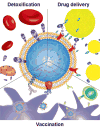Biointerfacing and Applications of Cell Membrane-Coated Nanoparticles
- PMID: 27798829
- PMCID: PMC5471317
- DOI: 10.1021/acs.bioconjchem.6b00569
Biointerfacing and Applications of Cell Membrane-Coated Nanoparticles
Abstract
The cell membrane-coated nanoparticle is a biomimetic platform consisting of a nanoparticulate core coated with membrane derived from a cell, such as a red blood cell, platelet, or cancer cell. The cell membrane "disguise" allows the particles to be perceived by the body as the source cell by interacting with its surroundings using the translocated surface membrane components. The newly bestowed characteristics of the membrane-coated nanoparticle can be utilized for biological interfacing in the body, providing natural solutions to many biomedical issues. This Review will cover the interactions of these cell membrane-coated nanoparticles and their applications within three biomedical areas of interest, including (i) drug delivery, (ii) detoxification, and (iii) immune modulation.
Figures







Similar articles
-
Core-shell supramolecular gelatin nanoparticles for adaptive and "on-demand" antibiotic delivery.ACS Nano. 2014 May 27;8(5):4975-83. doi: 10.1021/nn501040h. Epub 2014 Apr 14. ACS Nano. 2014. PMID: 24716550
-
Engineering biological interactions on the nanoscale.Curr Opin Biotechnol. 2019 Aug;58:1-8. doi: 10.1016/j.copbio.2018.10.005. Epub 2018 Nov 1. Curr Opin Biotechnol. 2019. PMID: 30390535 Free PMC article. Review.
-
Cell membrane-coated nanoparticles: research advances.Nanomedicine (Lond). 2020 Mar;15(6):625-641. doi: 10.2217/nnm-2019-0388. Epub 2020 Feb 26. Nanomedicine (Lond). 2020. PMID: 32098564 Review.
-
Cell membrane coated nanoparticles: next-generation therapeutics.Nanomedicine (Lond). 2017 Nov;12(21):2677-2692. doi: 10.2217/nnm-2017-0225. Epub 2017 Oct 2. Nanomedicine (Lond). 2017. PMID: 28965474 Review.
-
Hybrid Membrane-Coated Biomimetic Nanoparticles (HM@BNPs): A Multifunctional Nanomaterial for Biomedical Applications.Biomacromolecules. 2021 Aug 9;22(8):3149-3167. doi: 10.1021/acs.biomac.1c00440. Epub 2021 Jul 6. Biomacromolecules. 2021. PMID: 34225451 Review.
Cited by
-
Biomimetic Nanoemulsions for Oxygen Delivery In Vivo.Adv Mater. 2018 Dec;30(49):e1804693. doi: 10.1002/adma.201804693. Epub 2018 Oct 8. Adv Mater. 2018. PMID: 30294884 Free PMC article.
-
Engineered Cell Membrane-Derived Nanoparticles in Immune Modulation.Adv Sci (Weinh). 2021 Dec;8(24):e2102330. doi: 10.1002/advs.202102330. Epub 2021 Oct 24. Adv Sci (Weinh). 2021. PMID: 34693653 Free PMC article. Review.
-
Re-engineered imaging agent using biomimetic approaches.Wiley Interdiscip Rev Nanomed Nanobiotechnol. 2022 Jan;14(1):e1762. doi: 10.1002/wnan.1762. Epub 2021 Oct 26. Wiley Interdiscip Rev Nanomed Nanobiotechnol. 2022. PMID: 34698438 Free PMC article. Review.
-
Biomimetic Nanotechnology toward Personalized Vaccines.Adv Mater. 2020 Apr;32(13):e1901255. doi: 10.1002/adma.201901255. Epub 2019 Jun 17. Adv Mater. 2020. PMID: 31206841 Free PMC article. Review.
-
Membrane-wrapped nanoparticles for photothermal cancer therapy.Nano Converg. 2022 Aug 12;9(1):37. doi: 10.1186/s40580-022-00328-4. Nano Converg. 2022. PMID: 35960404 Free PMC article. Review.
References
Publication types
MeSH terms
Substances
Grants and funding
LinkOut - more resources
Full Text Sources
Other Literature Sources

